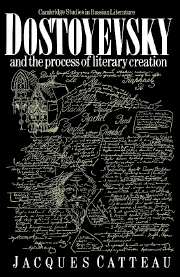Book contents
- Frontmatter
- Contents
- Preface to the English edition
- List of abbreviations
- General editor's note on transliteration and references
- General introduction
- PART I The creative environment
- PART II The process of creation
- Part III Time and space in the world of the novels
- Conclusion
- Notes
- Select bibliography
- Index of names
Conclusion
Published online by Cambridge University Press: 18 December 2009
- Frontmatter
- Contents
- Preface to the English edition
- List of abbreviations
- General editor's note on transliteration and references
- General introduction
- PART I The creative environment
- PART II The process of creation
- Part III Time and space in the world of the novels
- Conclusion
- Notes
- Select bibliography
- Index of names
Summary
After describing the creative environment, after being present at the birth of the novel, after analysing the novel's basic temporal and spatial structures, we are at last in a position to give a reply to our question about the why and how of Dostoyevsky's creation, to attempt a synthesis of his art, or, in other words, to define Dostoyevsky's fascinating and enthralling qualities, and give him his due not only as poet but as artist.
It is in his treatment of time and space that Dostoyevsky reveals his art. Time is the fundamental structure for the tragic experience of the hero, his painful struggle to grasp his freedom when freedom is denied him. Time is an obstacle to the exercise of freedom, since it transforms every free act into a predestined act and thus establishes destiny. But time is also the movement in which freedom, or choice, is accomplished. Instead of recognising this antinomy, as Tolstoy does at the end of War and Peace in his long dissertation on necessity and human freedom, Dostoyevsky renounces epic and biographical time. He does violence to nature not by refusing real time but by accentuating its natural contradictions. He subverts it by accelerating and compressing it, saturating it with events; he forces his heroes to experience time more painfully than in everyday life, sometimes allowing them to quench their ontological thirst in the circular time of eternity, in a harmonious and unreal reconciliation with universal being. He saves his hero from the mutilation of time by imprinting on it an ascending spiral movement, a real progression founded on falsely repetitive parallels.
- Type
- Chapter
- Information
- Dostoyevsky and the Process of Literary Creation , pp. 444 - 447Publisher: Cambridge University PressPrint publication year: 1989

